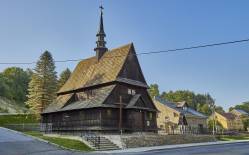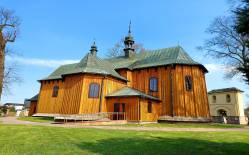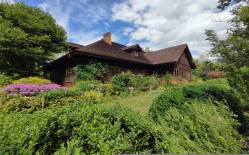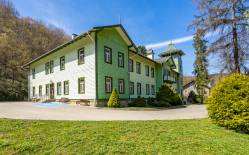North from Krosno, there are several villages which once constituted a kind of “Ruthenian island” within the Dynów Foothills. Its end came with the deportations in the 1940s. A few tserkvas which have survived here bear witness to the former inhabitants of this land.
The most impressive among the wooden churches in this area is the tserkva of the Protection of the Mother of God which originally was built in the 1600s, but acquired its final form in 1841. The alterations were completed by the carpenter Ioan Lisko. After 1947 it was acquired by Roman Catholics. Today it is a branch church of the Transfiguration of Our Lord, part of parish in Żyznów.
The nave is covered with wood board ceiling with a cove. In the remaining parts there are flat ceilings also clad with wood boards. The walls and ceilings feature polychrome decorations painted by Paweł Bogdański in 1898. The frieze on the chancel ceiling was contributed in 1933 by Paweł Zaporiżski, a soldier of Symon Petliura. After the Polish-Soviet war he was interned in Pikulice near Przemyśl, and after he was released, he stayed there and opened his workshop.
The chancel and part of the nave were built in the 1600s. The alterations and reconstruction carried out in 1841 changed the appearance of the church completely. Those resettled from here in the 1940s took some of the church furnishings to their new homeland.
The church is oriented towards the east, and its outer structure comprises two parts. The nave is connected with the chancel which is enclosed with semi-hexagonal walls. The nave and the chancel are covered with peaked roof, and the tower features a hip roof. On top of all the three parts we can see small turrets.
The old Greek Catholic cemetery was renovated in 2008. It is located on an elevation near the tserkva. Thirty-eight tombstones were restored, the oldest dating from 1902. Legible names of the deceased can be seen on some of them.
Photo: Krystian Kłysewicz
Gallery
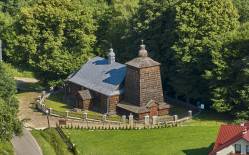
Recommended venues on the Trail



This website has been modernized with the financial support of the European Union under the Cross-Border Cooperation Programme Poland-Belarus-Ukraine 2014-2020. The responsibility for its content lies solely with the Podkarpackie Regional Tourism Board and cannot, in any case, be treated as a reflection of the position of the European Union, the Managing Authority, or the Joint Technical Secretariat of the Cross-Border Cooperation Programme Poland-Belarus-Ukraine 2014-2020.










